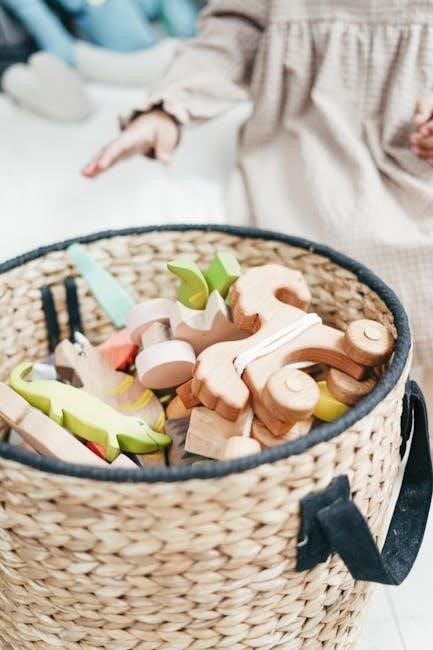Nursery Curriculum PDF: A Comprehensive Guide
Navigating the world of early childhood education can be overwhelming! This guide offers a comprehensive overview of nursery curricula, focusing on key frameworks like EYFS, core learning areas, and diverse curriculum models such as Montessori and Reggio Emilia, providing invaluable insights for educators and parents․
Nursery curricula form the bedrock of early childhood education, playing a pivotal role in shaping a child’s cognitive, social, emotional, and physical development during these formative years․ These curricula are carefully designed frameworks outlining learning experiences and activities tailored to young children’s unique developmental needs․ Understanding the principles and approaches behind various nursery curricula is essential for educators and parents alike․
Several curriculum models exist, each with its distinct philosophy․ The EYFS framework in the UK provides a structured yet flexible approach, while models like Montessori and Reggio Emilia prioritize child-led learning and exploration․ Effective curricula integrate play-based learning, fostering creativity, critical thinking, and problem-solving skills․ Furthermore, promoting literacy, developing mathematical skills, and fostering social-emotional development are crucial components․
Addressing individual needs through inclusive practices ensures that every child can thrive․ Collaboration between parents and carers is vital for reinforcing learning at home․ Utilizing available resources and facilities effectively enhances the learning environment․ Ultimately, well-planned and assessed curricula lay a strong foundation for future academic success and lifelong learning․
The Importance of Early Childhood Education
Early childhood education, particularly within a structured nursery environment, holds immense significance for a child’s holistic development․ These formative years are crucial for establishing a strong foundation for future learning and success․ High-quality early education programs provide children with opportunities to develop essential cognitive, social, emotional, and physical skills․ Through play-based activities and guided interactions, children acquire fundamental knowledge, develop problem-solving abilities, and enhance their communication skills․
Moreover, early childhood education fosters social-emotional development, enabling children to build positive relationships, learn to cooperate, and develop empathy․ These skills are vital for navigating social situations and building a strong sense of self․ A well-designed nursery curriculum also promotes literacy and numeracy skills, preparing children for the transition to primary school․
Furthermore, early intervention through targeted educational programs can address individual needs and support children with learning difficulties or developmental delays․ Parental involvement and strong home-school partnerships further enhance the benefits of early childhood education, creating a supportive learning environment that nurtures a child’s full potential and sets them on a path towards lifelong learning․
Key Frameworks: EYFS in the UK
The Early Years Foundation Stage (EYFS) framework stands as a cornerstone of early childhood education in the United Kingdom, providing a comprehensive set of standards that all registered early years providers must adhere to․ This framework ensures that all children from birth to five years old receive quality care and education․ The EYFS framework is built upon four guiding principles: every child is a unique child, children learn to be strong and independent through positive relationships, children learn and develop well in enabling environments, and children develop and learn in different ways and at different rates․
The EYFS framework outlines seven areas of learning and development: communication and language; physical development; personal, social and emotional development; literacy; mathematics; understanding the world; and expressive arts and design․ These areas are interconnected and should be delivered through play-based learning experiences that are tailored to meet the individual needs of each child․
The EYFS framework also emphasizes the importance of ongoing assessment and observation to track children’s progress and identify any areas where they may need additional support․ By adhering to the EYFS framework, nurseries in the UK provide a structured yet flexible learning environment that fosters children’s holistic development and prepares them for future success․
Core Areas of Learning and Development
A well-rounded nursery curriculum encompasses several core areas of learning and development, each playing a crucial role in shaping a child’s future․ Communication and Language is paramount, focusing on developing children’s speaking, listening, and comprehension skills․ This involves encouraging conversations, storytelling, and exposure to a rich vocabulary․ Physical Development is another key area, promoting gross and fine motor skills through activities like running, jumping, drawing, and building․
Personal, Social, and Emotional Development (PSED) focuses on building self-confidence, managing emotions, and forming positive relationships․ Activities include group play, sharing, and learning to understand and respect others’ feelings․ Literacy is introduced through exposure to books, rhymes, and early writing experiences, fostering a love of reading and writing․ Mathematics involves developing early numeracy skills through counting, sorting, and exploring shapes and patterns․
Understanding the World encourages children to explore their environment, learn about different cultures, and develop scientific thinking skills․ Finally, Expressive Arts and Design allows children to express themselves creatively through painting, music, dance, and imaginative play․ These core areas are interconnected and should be integrated into a holistic curriculum that caters to the individual needs and interests of each child․

Curriculum Models: Montessori, Reggio Emilia, HighScope
Several distinct curriculum models shape nursery education, each offering a unique approach to learning and development․ The Montessori method emphasizes child-led learning, where children explore a carefully prepared environment with specialized materials․ Teachers act as guides, supporting children’s independence and self-directed learning․ This model fosters concentration, self-discipline, and a love of learning;
The Reggio Emilia approach, originating in Italy, views children as capable and curious learners․ It emphasizes collaborative projects, in-depth exploration of topics, and the use of diverse materials to express ideas․ The environment is considered the “third teacher,” and documentation of children’s learning is a key component․ HighScope, another prominent model, focuses on active learning through plan-do-review cycles․
Children plan their activities, carry them out, and then reflect on their experiences․ This promotes problem-solving, decision-making, and self-evaluation skills․ Each model offers distinct advantages, and educators often adapt and integrate elements from different approaches to create a curriculum that best suits their specific context and the needs of the children they serve․ Understanding these models allows for informed curriculum choices․
Integrating Play-Based Learning
Play-based learning forms the bedrock of effective nursery education, recognizing that children learn best through active exploration and engagement․ It moves away from traditional, teacher-led instruction, instead prioritizing child-initiated activities that foster creativity, problem-solving, and social skills․ Through play, children develop essential cognitive abilities, language skills, and emotional intelligence․

Integrating play-based learning involves creating a stimulating environment filled with open-ended materials and opportunities for imaginative play․ This could include blocks, art supplies, dramatic play props, and natural materials․ Teachers act as facilitators, observing children’s play, providing support and guidance, and extending their learning through thoughtful questioning and interactions․ For example, a simple block-building activity can become a lesson in spatial reasoning, problem-solving, and collaboration․
Outdoor play is equally important, offering opportunities for physical activity, exploration of the natural world, and the development of gross motor skills․ Integrating play across the curriculum ensures that learning is engaging, meaningful, and relevant to children’s interests and experiences․ This approach promotes a love of learning and sets a strong foundation for future academic success, allowing children to learn whilst having fun․
Promoting Literacy in the Nursery
Literacy development in the nursery years is a crucial foundation for future academic success․ It involves fostering a love of reading and writing, developing phonological awareness, and building vocabulary․ A literacy-rich environment provides children with ample opportunities to interact with books, print, and language in meaningful ways․ Regular story times, interactive reading sessions, and access to a wide range of books are essential components․
Promoting literacy also involves encouraging children to explore writing and mark-making․ Providing access to various writing materials, such as crayons, pencils, and paper, allows children to experiment with letter formation and express their ideas․ Creating a print-rich environment, labeling objects, and displaying children’s work further reinforces the connection between spoken and written language․ Activities like singing songs and rhyming games enhance phonological awareness, a key skill for learning to read․
Furthermore, incorporating literacy into play-based activities makes learning engaging and fun․ Dramatic play, for example, can provide opportunities for children to use language in context, create stories, and develop their communication skills․ By integrating literacy across the curriculum, nurseries can foster a lifelong love of reading and writing, setting children on a path to becoming confident and capable communicators, which is essential for social development․
Developing Mathematical Skills
Developing mathematical skills in the nursery is about more than just counting; it’s about fostering a sense of number, spatial awareness, and problem-solving abilities․ A well-rounded nursery curriculum integrates mathematical concepts into everyday activities, making learning fun and relevant․ This includes providing opportunities for children to explore shapes, patterns, and measurements through play and exploration․

Hands-on activities are crucial for developing mathematical understanding․ Using manipulatives like blocks, beads, and counters allows children to visualize and manipulate numbers and quantities․ Sorting and classifying objects by color, shape, or size helps develop logical thinking and problem-solving skills․ Cooking activities provide opportunities to measure ingredients and follow instructions, integrating math into practical tasks;
Integrating math into storytelling and songs can also make learning more engaging․ Counting songs and stories with mathematical themes can help children develop number sense and vocabulary․ Outdoor play provides opportunities to explore spatial relationships, such as distance, direction, and position․ By creating a mathematically rich environment, nurseries can lay a strong foundation for future mathematical learning, and boost confidence as a result․ This support is invaluable for children as they grow․
Fostering Social and Emotional Development
Fostering social and emotional development in the nursery is paramount, laying the groundwork for future relationships and well-being․ A nurturing curriculum prioritizes creating a safe and supportive environment where children feel secure, valued, and understood․ This involves promoting self-awareness, empathy, and the ability to manage emotions effectively․
Activities designed to encourage cooperation and collaboration are essential․ Group games, collaborative art projects, and shared storytelling help children learn to work together, share ideas, and resolve conflicts peacefully․ Role-playing activities provide opportunities to explore different perspectives and practice empathy․ Circle time is a valuable tool for fostering a sense of community and belonging․
Supporting children in identifying and expressing their feelings is crucial․ Providing a vocabulary for emotions and creating opportunities for open communication helps children develop emotional literacy․ Books and stories that explore emotions can also be helpful․ Modeling positive social interactions and providing guidance on conflict resolution are key roles for nursery staff․ By prioritizing social and emotional development, nurseries can empower children to build strong relationships, navigate challenges, and thrive in all areas of their lives, promoting happiness and success․
Addressing Individual Needs and Inclusion
A truly effective nursery curriculum recognizes and celebrates the unique strengths and needs of each child․ Inclusion is not merely about physical presence, but about creating a learning environment where every child feels valued, respected, and supported to reach their full potential․ This requires a commitment to differentiation and personalized learning․
Careful observation and assessment are essential for identifying individual needs, whether they relate to learning styles, developmental delays, or specific learning disabilities․ Working closely with parents and specialists is crucial to developing individualized education plans (IEPs) that address specific goals and strategies․ Adapting activities and resources to meet diverse needs ensures that all children can participate and succeed․
Creating a sensory-rich environment with varied materials and activities caters to different learning preferences․ Providing opportunities for movement and exploration supports children with sensory processing needs․ Using visual aids, sign language, or other communication tools can enhance understanding for children with language delays․ Fostering a culture of empathy and acceptance among children promotes social inclusion and reduces the risk of bullying or exclusion․ By embracing diversity and addressing individual needs, nurseries can create a welcoming and inclusive environment where all children can thrive․
The Role of Parents and Carers
Parents and carers are integral partners in a child’s early education journey․ Their active involvement significantly enhances the effectiveness of the nursery curriculum and fosters a strong sense of continuity for the child․ Open communication between nursery staff and families is paramount․ Regular updates on a child’s progress, observations, and any emerging needs should be shared through various channels, such as parent-teacher meetings, online platforms, or informal conversations․
Nurseries should actively seek input from parents and carers regarding their child’s interests, strengths, and any specific concerns they may have․ This information can be invaluable in tailoring the curriculum to meet the individual child’s needs and preferences․ Encouraging parents to participate in nursery activities, such as reading stories, sharing cultural traditions, or assisting with special projects, strengthens the home-school connection․
Providing parents with resources and guidance on how to support their child’s learning at home reinforces the skills and concepts introduced in the nursery setting․ This can include suggestions for age-appropriate activities, recommended books, or tips on fostering literacy and numeracy skills․ By working collaboratively, nurseries and families can create a supportive and enriching environment that promotes the child’s overall development and prepares them for future success․ A welcoming open-door policy is essential․

Utilizing Resources and Facilities Effectively
A well-designed nursery curriculum thrives on the effective utilization of available resources and facilities․ This involves careful consideration of both indoor and outdoor spaces, as well as the strategic deployment of learning materials and equipment․ Maximizing the potential of the nursery environment requires a thoughtful approach to organization, accessibility, and adaptability․
Indoor spaces should be arranged to create distinct learning zones that cater to various developmental areas․ For example, a designated reading corner stocked with a diverse collection of books promotes literacy skills, while a construction area equipped with blocks and building materials encourages problem-solving and creativity․ Outdoor spaces offer opportunities for gross motor development, exploration of nature, and sensory experiences․
The curriculum should be designed to capitalize on the unique features of the nursery’s location and surroundings․ If the nursery has access to a garden, park, or natural environment, these resources can be integrated into learning activities to foster an appreciation for nature and promote environmental awareness․ Furthermore, technology can be used as a valuable tool to enhance learning experiences, providing access to interactive resources, educational games, and virtual field trips․ Staff skills are also important․
Regularly assessing the availability and suitability of resources ensures that the curriculum remains engaging, relevant, and responsive to the changing needs of the children․
Curriculum Planning and Assessment
Effective curriculum planning and assessment are vital components of a successful nursery program; Curriculum planning involves the development of a structured and intentional framework that outlines learning goals, activities, and experiences designed to promote children’s holistic development․ Assessment, on the other hand, is the ongoing process of gathering and analyzing information about children’s learning and progress․
The curriculum should be aligned with relevant frameworks, such as the Early Years Foundation Stage (EYFS) in the UK, and should be tailored to meet the unique needs and interests of the children․ Planning should be flexible and responsive, allowing for adjustments based on children’s emerging interests and developmental progress․ A play-based learning approach should be integrated into the curriculum, providing opportunities for children to learn through exploration, experimentation, and social interaction․
Assessment should be an integral part of the curriculum, providing valuable insights into children’s strengths, areas for development, and learning styles․ Observation, documentation, and formative assessment techniques should be used to gather evidence of children’s learning․ This information should be used to inform planning, personalize instruction, and track children’s progress over time․ Regular communication with parents and carers is essential to share assessment findings and collaborate on strategies to support children’s learning and development․
By implementing a robust curriculum planning and assessment process, nurseries can create a stimulating and nurturing environment that fosters children’s optimal growth and development․
